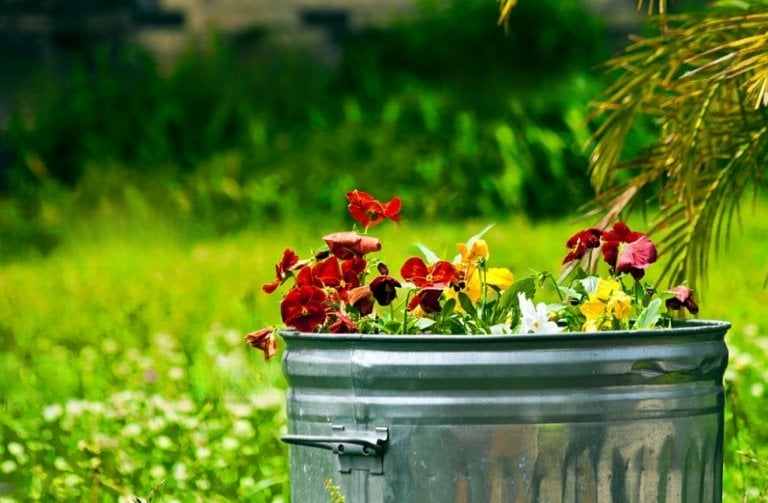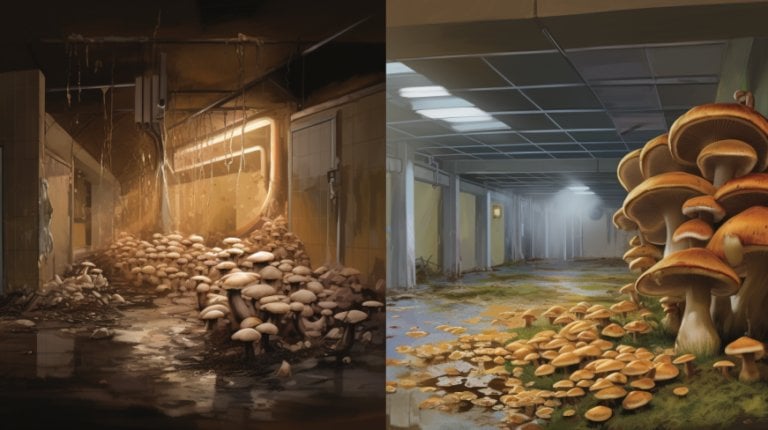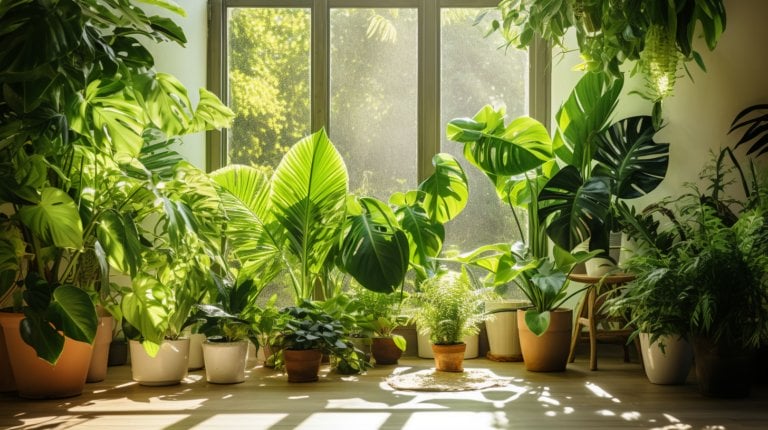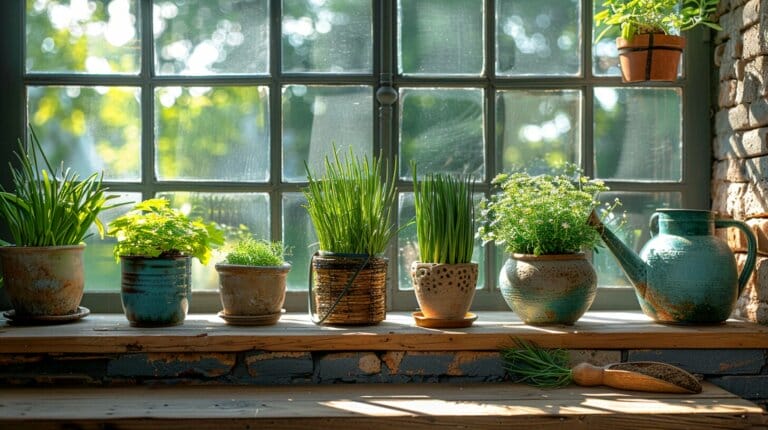Small Purple Perennial Flowers: Ultimate List of Hardy Purple Blooms
Envision stepping into a garden where the charms of twilight sketch a calm enchantment all around. This is not about flashy, outsized blooms vying for attention. Instead, it centers on the understated pleasure of modest purple perennial flowers that captivate with their simple beauty and tenacity.
I have tended to these marvels across many seasons, and I’ve come to cherish how they bring depth and nuance to flower beds with their understated purple hues – an often overlooked palette in a world chasing after larger-than-life blooms.
These little dynamos challenge the notion that bigger always equates to better. Their compact elegance and hardiness allow them to excel in garden designs where others might shy away.
Within these lines lie insights from hands-on dedication: nurturing tips for year-round splendor and fresh design approaches ready to spark creativity in budding enthusiasts and experienced horticulturists.
So, welcome to this corner of violet vibrancy—where your garden is poised for its most profound infusion of color. Keep reading and unearth a collection of purple-hued gems that promise to enrich your own patch of green sanctuary.
Key Takeaways
- Small purple perennial flowers, such as Dwarf Purple Iris, Lavender, and Creeping Phlox, add subtle yet vibrant color to gardens.
- These hardy blooms attract bees and butterflies while requiring minimal maintenance in various soil and light conditions.
- Uncommon options like Freesia and Pasque Flower offer unique fragrances and resilience against pests – perfect for sustainable gardening practices.
The Allure of Purple in the Garden
Purple flowers in the garden grab your eye and make everything look grand. This color has a royal feel that lifts up a green space. Purple can mean many things: mystery, wisdom, peace, and pride.
Gardens shine when you mix these blooms with other colors like yellows and whites.
Many people love purple because it doesn’t clash; it fits perfectly with most plants. It’s also great for attracting bees and butterflies. These friends love to visit purple blooms all day long.
Planting small purple perennials is a smart way to keep your garden colorful from spring until fall.
Video on the allure of purple in gardens
Popular Small Purple Perennial Flowers
Dwarf Purple Iris (Iris reticulata), Spike Speedwell (Veronica spicata), Lavender (Lavandula species), Creeping Phlox (Phlox subulata), Periwinkle (Vinca minor), Horned Violet (Viola cornuta), Purple Geranium (Geranium x magnificum) and Crocus (Crocus sativus) are some of the most sought-after small purple perennial flowers for their delicate beauty and hardy nature.
Dwarf Purple Iris (Iris reticulata)
I love adding a splash of color to my garden, and the Dwarf Purple Iris is one of my favorites. This little beauty pops up in late winter or early spring, bringing vibrant purple blooms that can light up any flower bed.
Ideal for USDA hardiness zones 5-8, this particular iris loves basking in full to partial sun and thrives in well-drained soil.
Here’s a tip I’ve learned: make sure you plant them at the right spot from the start because these irises don’t like to be moved around once they’ve settled in. With their striking color and easy-going nature when it comes to care, they’re perfect for gardeners looking for a low-maintenance yet showy perennial.
Just picture those gorgeous petals opening up as some of the first signs of spring – it’s an unbeatable sight!
Spike Speedwell (Veronica spicata)
Spike Speedwell, or Veronica spicata, is a small wonder in my garden. It stands out with its violet star-shaped flowers that keep the show going from late spring to early fall. Moreover, deer leave it alone, and it doesn’t flinch even when winter hits as cold as -40 degrees F.
That’s a tough little plant!
Caring for Spike Speedwell is pretty straightforward. It likes sunny spots but can handle some shade, too. This beauty thrives well in zones 3-8, bringing life to flower beds with minimal fuss.
I ensure mine gets enough water without making the soil soggy and add mulch to keep weeds down. Every gardener should try this hardy purple bloom; it’s like a trooper in your floral army!
Lavender (Lavandula species)
Lavender is a beloved small purple perennial famous for its fragrant, delicate flowers and the essential oil it produces. It’s not only appealing to humans but also attracts bees and butterflies, making it an excellent addition to pollinator-friendly gardens.
Lavender is versatile; people use it for its aromatic properties, ornamental value, and medicinal benefits. Moreover, because of its strong scent, lavender acts as a natural pest repellent—keeping deer and rabbits at bay.
Lastly, this plant is winter-hardy and can thrive in full sun or partial shade with well-drained soil.
Creeping Phlox (Phlox subulata)
Creeping Phlox, or Phlox subulata, is a low-growing ground cover with delicate star-shaped flowers. It adds vibrant pops of purple to garden landscapes and is loved by butterflies and bees.
This plant thrives in USDA zones 3-9 and comes in purple varieties such as ‘Flame Blue’ or ‘Blue Paradise’. It requires well-drained soil and full sunlight to partial shade for optimal growth.
Planting in masses creates a stunning carpet of color that truly enhances any garden space.
Periwinkle (Vinca minor)
Periwinkle, or Vinca minor, is an evergreen groundcover that adds year-round appeal to gardens. It thrives in USDA zones 4-9. It can tolerate full sun or full shade, making it a versatile choice for different garden environments.
Its low-maintenance nature makes it an excellent option for sustainable gardening, and its ability to grow well in various soil and light conditions adds to its popularity among environmental enthusiasts.
Periwinkle is a perennial plant that brings depth, richness, and a pop of color to flower beds. With its resistance to pests and diseases, historical significance, and traditional uses, Periwinkle is a beautiful yet practical addition to any garden.
Horned Violet (Viola cornuta)
Horned violets are tough little plants that can survive in various conditions. They do well in USDA zones 3-9 or 5-9, and they prefer rich, moist, well-drained soil. However, you should watch out for pests like violet gall midges, snails, slugs, and spider mites which might target them.
Also, be mindful of powdery mildew if the environment is damp with poor airflow.
Violet roots can be harmful if ingested by humans but not by pets. Interesting fact – people have been known to drink violet tea for better sleep and create salves from crushed petals to soothe skin inflammation!
Purple Geranium (Geranium x magnificum)
Purple Geranium, also known as Purple Cranesbill Geraniums, is a beautiful perennial that blooms in shades of purple. It thrives in USDA hardiness zones 5-8 and prefers full to partial sun exposure.
This two-foot-tall plant is resistant to drought and deer, making it an excellent choice for sustainable gardening. Not only does it add beauty to the garden, but it also attracts beneficial butterflies and bees.
While caring for Purple Geranium, it’s important to note its susceptibility to pythium root rot and flower blight. Despite these challenges, the geranium essential oil derived from this plant offers various health benefits while being non-toxic to people and pets.
Crocus (Crocus sativus)
Crocus (Crocus sativus) thrives in full sun to partial shade and needs well-draining soil. Regular watering is essential for its growth. This plant blooms from late winter to early spring, adding color to your garden from winter to spring.
It’s important to note that Crocus is toxic to pets and susceptible to viral diseases. Interestingly, the red stigmas of Crocus are edible and highly prized as saffron spice, making it not only an aesthetic addition but also functional in your garden or landscape.
Uncommon Small Purple Perennials Worth Planting
Consider adding Freesia, Sweet Alyssum, Millenium Flowering Onion, and Pasque Flower to your garden for unique and captivating pops of purple. These lesser-known small purple perennials have the potential to enchant gardens with their beauty and charm.
Freesia (Freesia)
Freesias are lovely small purple perennial flowers to add a delightful fragrance to your garden. These plants are winter-hardy and grow well in zones nine to ten. You’ll want to plant them in rich, neutral, well-drained soil with plenty of sunlight.
Freesias aren’t just pretty but also non-toxic to people and pets.
I like how versatile freesias are – you can use them for flower beds, borders, or containers. They also have a wonderful scent often used in perfumes and lotions. Plus, they make excellent cut flowers for indoor arrangements! If you’re looking for a charming addition to your garden that’s both beautiful and fragrant, freesias could be the perfect fit!
Sweet Alyssum (Lobularia maritima)
I love Sweet Alyssum! It’s a hardy perennial that blooms in spring, summer, and fall. In USDA zones 5-9, it comes back every year. Sweet Alyssum likes full to partial sunshine, neutral to acidic soil, and moist but well-drained soil.
Oh, and it’s non-toxic to people and pets too! You can even sprinkle the peppery flowers on top of your salads for an extra kick.
Millenium Flowering Onion (Allium’ Millenium’)
I’m excited to share about the ‘Millenium’ flowering onion. This purple perennial is a tough plant, able to resist hungry rabbits, voles, and deer. It blossoms with small clusters of pale purple flowers that pollinators absolutely love.
Plus, it thrives in full sun and can withstand chilly winters down to -40 degrees F. With its hardiness and attractiveness to pollinators, this Allium is indeed a worthy addition to any sustainable garden!
Pasque Flower (Pulsatilla vulgaris)
I’m excited to discuss the Pasque flower, a lovely early-blooming purple perennial. It’s sturdy, can survive in really cold temperatures, and doesn’t attract deer. This plant loves well-drained soil and looks beautiful when it reseeds itself.
The Pasque flower is part of the 25 best purple perennials list for gardens, showing how versatile purple blooms can be in various landscapes.
This unique beauty brings a sense of elegance to any garden and delivers an authentic touch of nature. Planting these flowers will not only enhance your garden’s beauty but also support sustainable gardening practices due to their hardiness and ability to thrive without attracting pests like deer.
Care Tips for Small Purple Perennials
It is essential to consider their sunlight and shade preferences, soil and watering needs, and pruning and maintenance advice To ensure the optimal growth of small purple perennials.
Remember to provide adequate sunlight for these plants while also ensuring they receive enough water without overwatering. Additionally, be mindful of the specific soil types that each plant prefers and follow recommended pruning techniques to maintain healthy and vibrant blooms throughout the seasons.
Sunlight and Shade Preferences
Each small purple perennial flower has specific sunlight and shade preferences. Some prefer full sun for at least six hours a day, like lavender. Others, such as creeping phlox or horned violet, thrive in partial to full shade.
Understanding these preferences is vital for successfully growing these beautiful blooms in your garden. It’s crucial to consider each plant’s sunlight needs before deciding where to plant them.
Sunlight is critical in determining which small purple perennials will grow best in your garden. By understanding their individual needs, you can create an environment that allows these flowers to flourish and bring vibrant shades of purple year after year.
Soil and Watering Needs
It’s crucial to understand their soil and watering needs for healthy, small purple perennial flowers. These flowers vary in preference, some favoring well-draining soil while others thrive in moist conditions.
When watering, it’s essential to strike a balance to avoid waterlogging or drying the plants. Understanding each plant’s specific requirements is key to nurturing flourishing blooms.
Comprehending how different purple perennials interact with their environment can help gardeners make informed choices about where and how to plant them. This knowledge empowers individuals to create thriving, sustainable gardens that contribute positively to the ecosystem.
Pruning and Maintenance Advice
It’s essential to keep things simple when it comes to pruning and maintaining small purple perennials. Regular deadheading of spent blooms encourages continuous flowering throughout the growing season.
Additionally, in early spring, light trimming can promote bushier growth and prevent legginess. For maintenance, ensure well-draining soil and avoid overwatering, as most small purple perennials prefer drier conditions once established.
Utilize organic mulch to retain moisture and suppress weeds while providing a steady nutrient supply for healthy growth.
Design Ideas for Small Purple Perennials
Incorporating small purple perennials into your garden can add color and vibrancy to your landscape. Consider creating colorful borders with a mix of different shades of purple blooms, accenting rock gardens with low-growing varieties, and enhancing container plantings with trailing or compact purple flowers.
These design ideas will help you showcase the beauty of small purple perennials in creative and visually appealing ways.
Creating Colorful Borders
I love using small purple perennial flowers to create colorful borders in my garden. They add a pop of color and provide a stunning visual impact. By planting low-growing varieties like Creeping Phlox and Periwinkle along the edges, I can define the border with a vibrant burst of purple.
Taller options such as Spike Speedwell and Lavender look fantastic towards the back, adding depth to the border while attracting pollinators with their beautiful blooms.
Small purple perennials are so versatile for creating borders. Their varying heights and textures can be combined to establish visually appealing layers within the garden bed. Additionally, these plants are hardy and low-maintenance, making them perfect for sustainable gardening practices.
Accenting Rock Gardens
Purple perennial flowers can bring life and vibrancy to rock gardens with their rich hues. The low-growing habit of small purple perennials like Creeping Phlox, Dwarf Purple Iris, and Periwinkle makes them ideal for adding pops of color around rocks and boulders.
Their ability to thrive in dry soil also makes them a practical choice for the challenging conditions often found in rock gardens. Additionally, the aromatic blooms of Lavender can create a sensory experience that adds an extra dimension to the visual beauty of a rock garden.
Furthermore, the delicate spikes of flowers from plants like Spike Speedwell and Pasque Flower can add vertical interest to rock gardens without overshadowing the rugged natural elements.
Enhancing Container Plantings
Enhancing container plantings with small purple perennial flowers adds a vibrant touch to any porch or patio space. These blooms’ depth, richness, and pop of color create an inviting atmosphere while promoting sustainable gardening practices.
Choosing deer-resistant varieties ensures that the container plantings remain beautiful in areas with wildlife, providing a hassle-free gardening experience. Understanding each plant’s site preferences and growth habits empowers me to create visually stunning container arrangements with long-lasting blooms throughout the seasons.
When incorporating these purple perennials into container designs for patio or porch decors, it’s essential to consider their sunlight and shade preferences as well as soil and watering needs.
If you’re captivated by small purple perennial flowers, you’ll be equally fascinated to discover what tree has purple flowers, expanding your garden’s purple palette!
Conclusion
In conclusion, small purple perennial flowers bring depth and color to gardens. You can easily incorporate these hardy blooms into your garden. The strategies provided are practical, easy to implement, and efficient.
Applying these approaches can lead to significant improvements in your garden. Check out additional resources for continued learning and inspiration beyond this article! Let’s embrace the beauty of small purple perennials in our gardens!
FAQs
What are some small purple perennial flowers I can plant?
You can plant different kinds of small purple perennials like bellflower, lungwort, and vervain. They bloom in shades of purple and last for many years.
Can tall purple perennials grow in shady places?
Yes, plants like monkshood and aster love the shade, and they can grow to be several feet tall with beautiful dark purple flowers.
Are there any purple flowers that bloom all summer long?
Sure! You can look for a cultivar called Salvia or another one named Verbena; these are types of perennials that bloom with light or dark purples all through the summer months.
Do any early spring bloomers come in purple?
Absolutely! Crocuses are an iris family member that often have lovely light or deep-purple blooms, popping up as early spring bloomers.
How do I care for my bearded iris to keep them healthy?
Bearded irises like sunny spots, but remember to watch out for black rot or leaf spots on their leaves. Splitting the corms every few years helps, too!
What kind of tall, pest-resistant perennial could I add to my garden?
Look at Baptisia australis (blue wild indigo), which is part of the pea family; it grows about 3 feet in height, and its fern-like foliage stays semi-evergreen while resisting pests really well.






